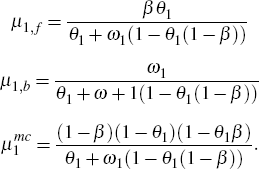RDP 2013-07: An Empirical BVAR-DSGE Model of the Australian Economy Appendix A: Log-linearised Equations of the Model
June 2013 – ISSN 1320-7229 (Print), ISSN 1448-5109 (Online)
- Download the Paper 658KB
This appendix lists the equations in the model. ~ denotes that a variable is a log deviation from the steady-state.
Recall that 1 denotes the domestic good sector, 2 the export sector, and *
foreign variables. Parameters which are functions of the steady state needed
for the log-linearised equations are in the subsequent appendix. We have eliminated
the nominal exchange rate from the model; all relationships are expressed in
terms of the real exchange rate.  , namely consumption of domestically produced
goods, has also been substituted out. As the economy-wide technology, Zt,
is non-stationary, many of the real variables have been normalised by the level
of technology, for example
, namely consumption of domestically produced
goods, has also been substituted out. As the economy-wide technology, Zt,
is non-stationary, many of the real variables have been normalised by the level
of technology, for example  . These are (not exclusively) denoted with
lower case letters. f is introduced so as the model can be log-linearised
around h = 0, and uses the approximation that ln(1 + x) ≈
x. It effectively linearises terms involving h. vm
is similar. See Table A1 for a description of all variables.
. These are (not exclusively) denoted with
lower case letters. f is introduced so as the model can be log-linearised
around h = 0, and uses the approximation that ln(1 + x) ≈
x. It effectively linearises terms involving h. vm
is similar. See Table A1 for a description of all variables.
| Variable | Description | Variable | Description |
|---|---|---|---|
| Variables which have been detrended | |||
| c | Consumption | i | Investment |
| w | Wages | va | Value added |
| mc | Marginal costs, domestic goods | h | Net foreign assets share of value added |
| y | Output | f | f ≡ h + 1 |
| m | Real money balances | tm | Real transfers |
| k | Capital | vm | vm ≡ tm + 1 |
| Other variables | |||
| R | Nominal interest rate | π | Domestic good inflation |
| π | Consumer inflation | r | Gross rental rate on capital |
| Ψ | Imports marginal costs | s | Consumer terms of trade  |
| L | Labour |  |
Nominal commodity prices in foreign currency |
| q | Tobin's Q |  |
Real commodity prices in foreign currency  |
| g | Growth in nominal money | Rer | Real exchange rate |
| Ω | Ω = κZ Lagrange multiplier on the budget constraint | ||
| Shocks | |||
| uc | Preference | um | Import mark-up |
| ui | Investment | a2 | Export sector technology |
| urp | Risk premium | a | Technology growth |
| ε | Monetary policy | ud | Domestic mark-up |
| The foreign VAR contains 4 reduced-form shocks | |||
| Observed variables | |||
| Δyobs | Output growth | πobs | Inflation |
| Δiobs | Investment growth | s*obs | Terms of trade |
| y*obs | Foreign output gap | Δrerobs | Change in the real exchange rate |
| robs | Interest rate | Δxobs | Change in exports |
A.1 Consumer
Lagrange multiplier on budget constraint
Euler equation
Labour supply, domestic goods
Labour supply, exports
Tobin's Q, domestic goods
Tobin's Q, exports
where  .
.
Investment, domestic goods
Investment exports
Capital accumulation, domestic goods
Capital accumulation, exports
Money demand
A.2 Domestic Good Firm
Phillips Curve
where
Marginal costs
Demand for capital
Demand for labour
A.3 Market Clearing
A.4 Importer
where the parameters are defined as per the domestic good.
A.5 Exporter
Labour demand
Capital demand
Production function
A.6 Open Economy
Uncovered interest parity
Net foreign assets
Real exchange rate and consumption terms of trade relationship
Consumption terms of trade growth
A.7 Autoregressive Processes
Technology growth
Risk premium
Preference shock
Export sector technology
Investment technology shock
A.8 Aggregates
CPI inflation
Value added
A.9 Monetary Policy
Taylor rule
Growth in nominal money
Real transfers
A.10 Foreign Sector
The foreign sector is modelled as a BVAR in the foreign output gap, inflation, interest rates and the detrended Australian terms of trade.
A.11 Measurement Equations
As the observed data have been demeaned, constants are omitted from the measurement equations.
Output growth
Investment growth
Foreign output gap
Interest rate
Foreign interest rates
Inflation
Foreign inflation
Terms of trade
Change in the real exchange rate
Change in exports












































